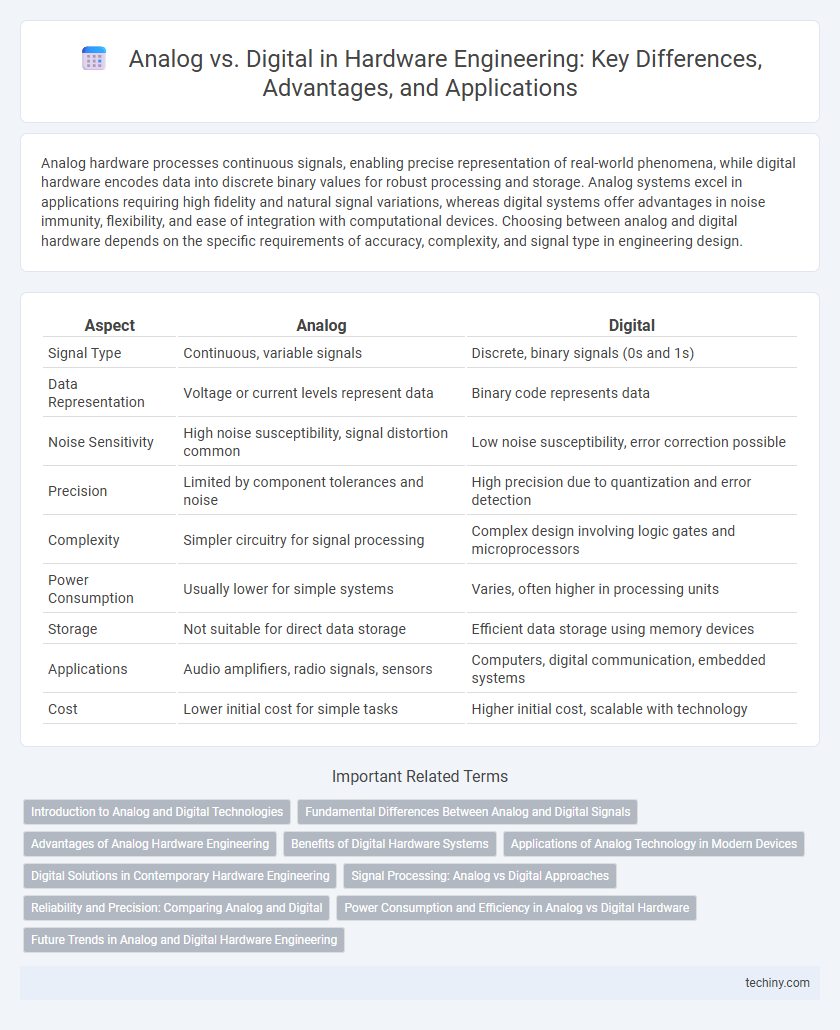Analog hardware processes continuous signals, enabling precise representation of real-world phenomena, while digital hardware encodes data into discrete binary values for robust processing and storage. Analog systems excel in applications requiring high fidelity and natural signal variations, whereas digital systems offer advantages in noise immunity, flexibility, and ease of integration with computational devices. Choosing between analog and digital hardware depends on the specific requirements of accuracy, complexity, and signal type in engineering design.
Table of Comparison
| Aspect | Analog | Digital |
|---|---|---|
| Signal Type | Continuous, variable signals | Discrete, binary signals (0s and 1s) |
| Data Representation | Voltage or current levels represent data | Binary code represents data |
| Noise Sensitivity | High noise susceptibility, signal distortion common | Low noise susceptibility, error correction possible |
| Precision | Limited by component tolerances and noise | High precision due to quantization and error detection |
| Complexity | Simpler circuitry for signal processing | Complex design involving logic gates and microprocessors |
| Power Consumption | Usually lower for simple systems | Varies, often higher in processing units |
| Storage | Not suitable for direct data storage | Efficient data storage using memory devices |
| Applications | Audio amplifiers, radio signals, sensors | Computers, digital communication, embedded systems |
| Cost | Lower initial cost for simple tasks | Higher initial cost, scalable with technology |
Introduction to Analog and Digital Technologies
Analog technology processes continuous signals that vary smoothly over time, commonly used in audio and radio frequency applications where signal fidelity is crucial. Digital technology represents information using discrete binary values, enabling error correction, data compression, and efficient processing in modern computing and communication systems. Understanding the fundamental differences between analog and digital signals is essential for designing hardware that meets specific performance, accuracy, and reliability requirements.
Fundamental Differences Between Analog and Digital Signals
Analog signals represent continuous waveforms that vary smoothly over time, capturing infinite values within a range, making them ideal for representing real-world phenomena such as sound and temperature. Digital signals encode data as discrete binary values, typically represented by 0s and 1s, enabling robust error detection, noise immunity, and ease of processing in hardware systems. Fundamental differences hinge on signal representation, noise susceptibility, and processing methods, where analog signals are vulnerable to distortion whereas digital signals facilitate precise and reliable information transmission and manipulation in hardware engineering.
Advantages of Analog Hardware Engineering
Analog hardware engineering provides superior signal fidelity and continuous data representation, enabling precise handling of real-world phenomena such as sound, temperature, and light. It offers lower latency and simpler circuitry for specific applications like audio amplifiers and sensor interfaces, reducing complexity and power consumption. Analog systems excel in environments requiring real-time processing with minimal quantization noise and distortion.
Benefits of Digital Hardware Systems
Digital hardware systems offer precise signal processing capabilities, enhancing accuracy and reliability in complex computations. These systems facilitate easier integration with software, enabling rapid updates and scalability across various applications. Their inherent noise immunity and consistency in performance make digital hardware ideal for modern electronics and communication devices.
Applications of Analog Technology in Modern Devices
Analog technology plays a crucial role in modern devices such as sensors, audio equipment, and telecommunications, enabling precise signal processing and real-time data conversion. Applications include temperature monitoring systems, medical instruments like ECG machines, and radio frequency transmissions where continuous signal variation is essential. These analog components ensure high fidelity and accuracy in environments requiring detailed signal interpretation and responsive control.
Digital Solutions in Contemporary Hardware Engineering
Digital solutions in contemporary hardware engineering offer enhanced precision, scalability, and integration compared to analog systems. Advanced digital signal processors (DSPs) and field-programmable gate arrays (FPGAs) enable complex computations and real-time data processing with minimal latency. These technologies drive innovations in embedded systems, communication devices, and automation, optimizing performance and reducing energy consumption.
Signal Processing: Analog vs Digital Approaches
Analog signal processing manipulates continuous signals, preserving the waveform's natural variations for real-time applications, such as audio amplification and sensor interfacing. Digital signal processing converts analog signals into discrete numerical values, enabling complex algorithms, noise reduction, and error correction using microprocessors or DSP chips. The choice between analog and digital approaches depends on factors like precision, noise immunity, processing speed, and system complexity in hardware engineering designs.
Reliability and Precision: Comparing Analog and Digital
Analog hardware excels in delivering continuous signal representation, offering high precision for applications requiring subtle variations, but is more susceptible to noise and component degradation affecting reliability. Digital hardware provides robust performance with discrete signal processing, enhancing reliability through error detection and correction, though precision is limited by bit resolution and sampling rates. Reliability in hardware engineering often favors digital systems for consistent operation, while precision demands careful consideration of analog design techniques and calibration.
Power Consumption and Efficiency in Analog vs Digital Hardware
Analog hardware often consumes less power than digital circuits when processing continuous, low-frequency signals due to the absence of constant clock-driven switching. Digital hardware excels in efficiency for complex computations and high-speed operations by leveraging techniques like power gating and dynamic voltage scaling. Comparing analog and digital power consumption depends on application-specific factors such as signal frequency, precision requirements, and operational complexity.
Future Trends in Analog and Digital Hardware Engineering
Future trends in analog and digital hardware engineering emphasize the integration of advanced semiconductor materials and AI-driven design automation. Innovations in analog circuits focus on enhancing low-power performance and precision sensing for IoT and wearable devices. Digital hardware evolution accelerates through increased adoption of heterogeneous computing and quantum-resistant cryptographic processors.
Analog vs Digital Infographic

 techiny.com
techiny.com